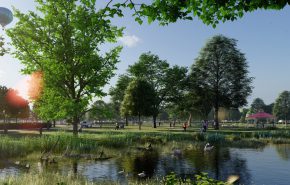More people are living in municipalities than ever before—this trend in urbanization calls for creative planning, financing, and design solutions to develop urban areas that are livable—today and for posterity. GAI’s Road to Recovery Series is designed to share new ideas to help communities take advantage of economic, cultural, and placemaking opportunities in the post-recession recovery. In this article, we talk with GAI’s Director of Community Solutions Pete Sechler, PLA, AICP about what he sees as the three principle elements to building community character and creating a sense of place: safe neighborhoods, livable corridors, and vibrant downtowns.
According to McKinsey & Company, the global number of urbanites is the highest in history and growing fast—by 60 million per year. By 2030, 60 percent of the world population—almost five billion people—will be city dwellers. By 2050, that figure will rise to 70 percent.
The three principle elements to building community character and creating a sense of place: safe neighborhoods, livable corridors, and vibrant downtowns.
Your passion is building a stronger sense of community for people. You say the first piece to achieving this is to create safe neighborhoods. Can you explain?
Pete: “Safe neighborhoods require at least five essentials: diverse housing choices, walkable streets with proximate parks and trails, quality schools and community services, basic daily retail, and a strong social fabric. Our neighborhoods need to be navigable by both children and seniors—yet, in many places, development patterns work to separate and isolate spontaneous social interaction, community access, and exercise out of our neighborhoods: you have to get in your car to drive to a facility to exercise or go to school. People should be able to hop on a bike, ride down the street to the local park, and recreate in their own neighborhood. Overall, we need connectivity between neighborhoods and basic community infrastructure, such as shared, multiuse facilities, flexible open spaces, strong organizations around schools, and livable, walkable streets.”
How do we develop livable corridors?
Pete: “For corridors to be livable, they need to balance moving cars with moving people. That means providing local multimodal access while still providing regional connectivity. Roads also need to support mixed-use development. Unfortunately, in order to solve regional transportation needs, many corridors are singularly configured to move as many cars as fast as possible—often impacting both community character and the viability of businesses and properties alongside those corridors. From a land use and zoning point of view, when a road becomes too big, too fast, and physically unattractive, it is often deemed unsuitable for pedestrians, bicycles, and diverse land uses. As a result, the land use rights and single-use commercial zoning of many corridors is often determined by the character of the road, not by the capability of the market to support that commercial environment. If we can rebalance the road to move cars at a calmer rate of speed with more pedestrian and environmental features, then the corridor can support a broader array of market-driven land uses, mixed-use development, and be supportive of walking, biking, and transit. And the corridor’s businesses will be more accessible to nearby neighborhoods. In essence, we’ve repositioned the road to be more successful as a meaningful, socioeconomic community place that seams neighborhoods together—rather than dividing them.”
You note a third aspect of developing community character is to maintain and enhance vibrant downtowns. How do we accomplish that?
Pete: “Vibrant downtowns need to have viable main streets within sustainable cultural areas that are meaningful to the entire community. We need to do things to breathe new life into main streets, which can involve transformative “Big Ideas,” as well as small interventions of “tactical urbanism and micro-finance.” Accomplishing this effort requires both new and tried and true methods. Small businesses can be organized locally through a variety of mechanisms and supported with economic incentives to assist in addressing the unique challenges of investment in historic areas. People increasingly want to live near interesting, authentic places, so local businesses need to have proximate mixed-use housing, where anyone from college students, “singles and mingles,” families, and retirees will want to live. With historic downtowns, it’s especially important to preserve and enhance their cultural legacy, tradition, and character—each town is its own unique place, and it’s essential to maintain that authenticity.”
Developing a public realm that expands the sense of pride and appreciation for a place is important if we’re going to have strong communities where people support one another and enjoy living. For more information on placemaking and building community character, contact Pete Sechler at 407.423.8398.
Stay tuned for our next article in GAI’s Road to Recovery series. Here, Senior Directors Tom Kohler and Owen Beitsch, PhD, FAICP, CRE discuss the value of public-private partnerships and how communities can do more today with fewer resources.


